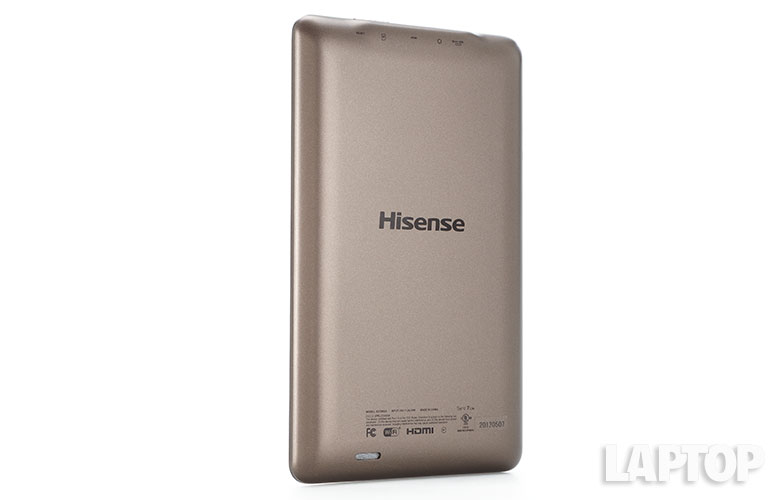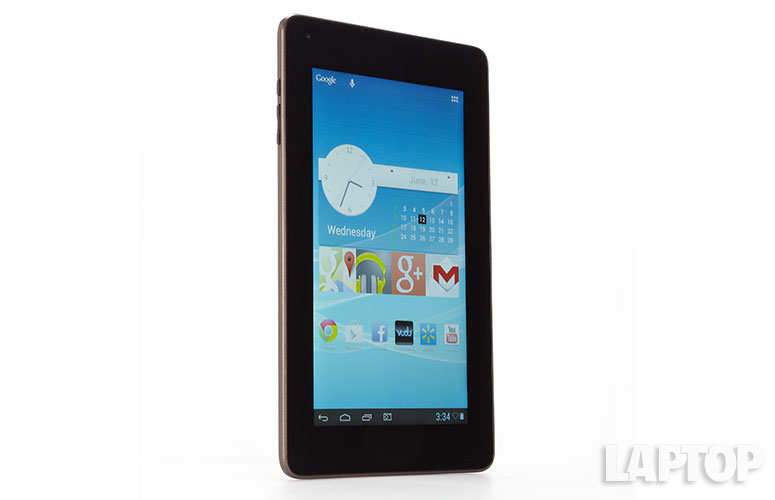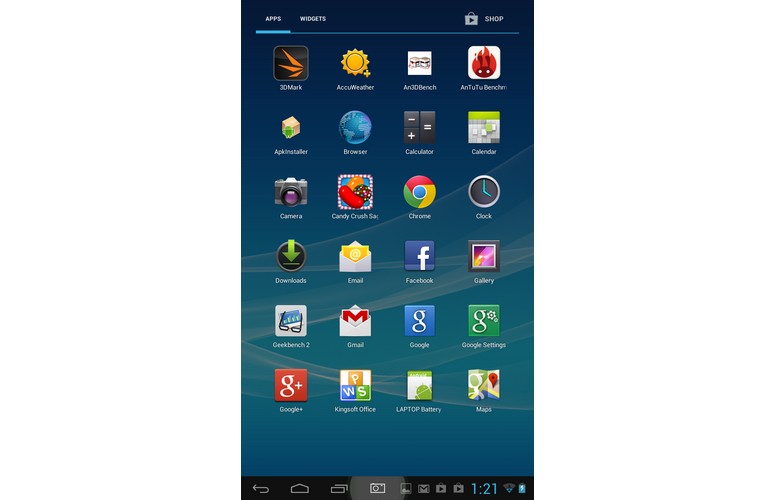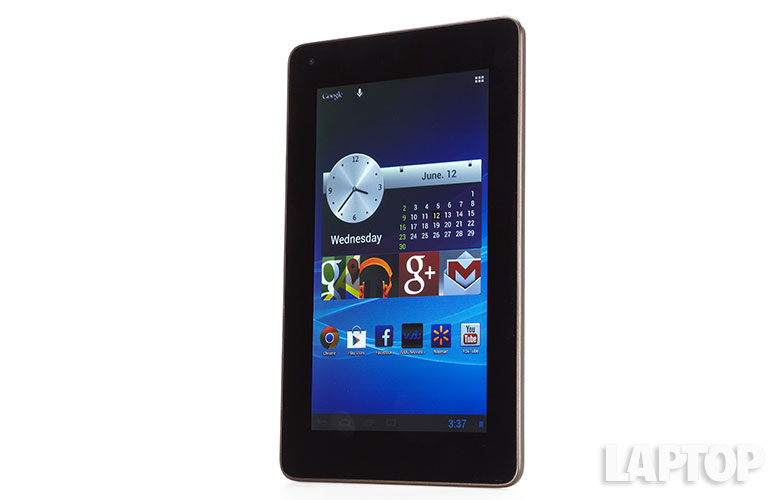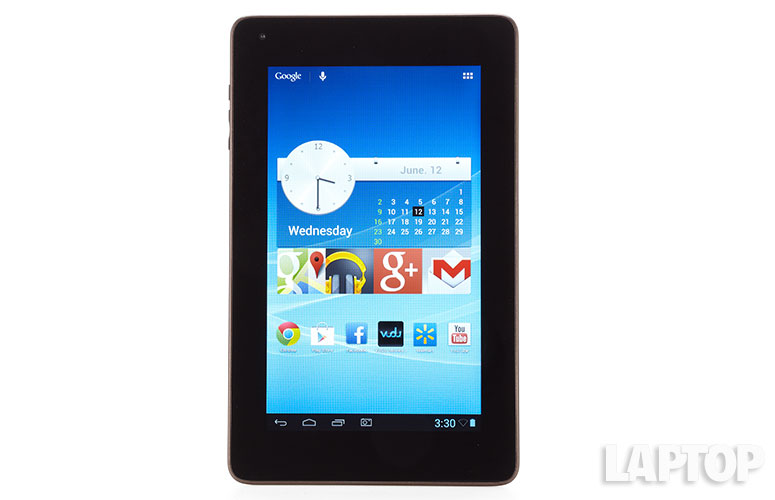Laptop Mag Verdict
The Hisense Sero 7 LT is an Android tablet that offers fairly good performance, a higher-resolution screen than its competitors' and expandable memory, all for just $99.
Pros
- +
Strong specs and performance for price
- +
Expandable memory via microSD
- +
Competent game performance
- +
Very affordable
Cons
- -
Puny onboard storage
- -
Below-average battery life
- -
Inconsistent app performance
Why you can trust Laptop Mag
Hisense is making quite a splash with its $149 Sero 7 Pro, offering Nexus 7-like performance and a microSD slot, for $50 less than Google's tablet. Now, here comes the $99.99 Sero 7 LT. This Wal-Mart exclusive boasts better specs than pricier entrants from ASUS and HP, making it one of the few sub-$100 slates we recommend.
Design
Click to EnlargeThe Sero 7 LT is unsurprisingly similar to the $149 Sero 7 Pro in size, shape and looks. However, whereas the Pro has a textured back, the LT's is smooth. Its brown metallic finish resists fingerprints well, and though we like the soft-touch finish of the $79 D2 Pad 712, the LT has a more premium feel. Both beat the glossy back of the $79 Ematic Genesis Prime, which was a fingerprint magnet.
The LT's display is flush with the bezel, a feature that should be standard on all tablets, regardless of price. Unfortunately, the Coby Kyros didn't get the memo.
MORE: Tablet Buyers' Guide: 5 Questions to Ask Before You Buy
Click to EnlargeWhen held vertically, the top of the Sero 7 LT houses the microUSB and mini HDMI-out ports, as well as a 3.5mm headphone jack and a microSD slot (accepting cards up to 32GB). The power button and volume controls sit on the upper-left-hand side. You'll find a speaker on the back and a 0.3-MP webcam is up front, above the display on the left.
Just like the Kyros, D2 and Ematic tablets, the Sero 7 LT has 4GB of onboard storage, and can accept microSD cards up to 32GB. In comparison, the ASUS MeMO Pad offers no card reader, but more onboard storage at 16GB, while the HP Slate 7 houses 8GB of onboard memory that's expandable to 40GB via microSD.
Sign up to receive The Snapshot, a free special dispatch from Laptop Mag, in your inbox.
This budget slate measures 7.6 x 4.7 x 0.4 inches and weighs 12.6 ounces. The Genesis Prime, Kyros and D2 Pad are all lighter, however, at 9.6 ounces, 10.2 ounces and 11.2 ounces, respectively, despite having similar dimensions as those on the Sero 7 LT. The MeMO Pad is almost identical in terms of size and weight (7.7 x 4.6 x 0.4 inches, 12.5 ounces), while the metal-framed Slate 7 is slightly taller, thicker and heavier, at 7.8 x 4.6 x 0.42 inches and 13.1 ounces.
Display
Click to EnlargeThe Sero 7 LT's 7-inch display has an underwhelming resolution of 1024 x 600 pixels, but that's an improvement over those of other $99 tablets. The Kyros, D2 Pad and Genesis Prime all sport 800 x 480 displays. In fact, the LT's screen has the same resolution as the MeMO Pad and Slate 7, which cost $50 and $70 more, respectively. That said, the $149 Sero 7 Pro has an IPS screen with a resolution of 1280 x 800.
With a brightness reading of 204 lux, the Sero 7 LT falls behind the category average of 367 lux, but trounces the Kyros (174 lux) and the Genesis Prime (166 lux). However, it was bested by the D2 Pad (253 lux), as well as the MeMO Pad (293 lux), Slate 7 (313 lux) and Sero 7 Pro (369 lux).
When watching the latest "Man of Steel" trailer on the LT, we thought the blazing explosions as Krypton fell looked washed-out. From the red in Superman's cape to the varying blues in the Fortress of Solitude, colors were muted. Still, the LT offers a higher-quality viewing experience than other sub-$100 tablets.
The Sero 7 LT's screen wasn't as responsive as we would have liked. Within apps like YouTube, we sometimes had to touch the display more than once for our taps to register.
Audio
The single stereo speaker on the Sero 7 LT is nothing to write home about, but it does manage to best the audio on other $99 tablets. Though it can produce sound about as loud as the Sero 7 Pro can, the audio wasn't nearly as full. When listening to Daft Punk's new single, "Get Lucky," we thought Pharrell's vocals were drowned out at times by bass notes.
The Kyros and Genesis Prime couldn't even produce comparable volume, much less provide acceptable definition. The slightly larger speaker on the MeMO Pad 7 has the same issue, but it's much less pronounced.
Interface and keyboard
Click to EnlargeWhile not as up-to-date as the 4.2 Jelly Bean-equipped Sero 7 Pro, the Android 4.1 OS on the Sero 7 LT at least includes such features as Google Now. Otherwise, the layout on this tablet is rather standard, with a clock and calendar front and center on the home screen, and some major Google apps and services just underneath.
The Sero 7 LT comes with a standard Android keyboard, which we'd replace immediately with Google's new downloadable keyboard. You'll get trace typing and next-word prediction. Generally, we found typing in portrait mode faster with our thumbs than in landscape mode. Note that this tablet doesn't include haptic feedback.
MORE: 5 Best Keyboard Apps for Android
Apps
Click to EnlargeUnlike the Kyros and D2 Pad, the Sero 7 LT comes with Google Play preinstalled, putting more than 700,000 apps, games and more at your fingertips. Of the other sub-$100 tablets we've reviewed, only the Ematic Genesis Prime also has Google Play.
In addition to Facebook and Pandora, Hisense preloaded the Sero 7 LT with the Wal-Mart-owned Vudu for downloading movies and apps for, of course, Sam's Club and Wal-Mart. Hisense's Smart Remote app allows the device to interact with Hisense Smart TVs, and Kingsoft Office lets users edit and create Office documents.
MORE: 25 Best Android Apps
Performance
Click to EnlargeEquipped with a dual-core, 1.6 GHz processor and 1GB of RAM, the Sero 7 LT is best for Web browsing, social networking and light gaming. Those guts outclass, or at least match, what you'll find elsewhere in the budget-tablet space. However, the LT still felt as though it were trying to catch up with us in certain situations. For instance, there was a noticeable delay when we moved the device between portrait and landscape orientations.
Click to EnlargeApps and games yielded mixed results, with "Angry Birds Star Wars" ready to play in 8 seconds and "Dead Trigger" fully booting in 10 seconds. While we experienced no issues popping piggies in Angry Birds, we witnessed a general lack of detail as we slayed the undead in Dead Trigger, although play was smooth. In Google+, scrolling through updates was often choppy, while Google Now was swift and kept up with quick swipes of the touch screen.
The Sero 7 LT more than held its own in our benchmark tests. In AnTuTu, a general benchmark, this tablet scored 8,765. That bests the category average of 8,357 and blows away the Kyros (3,362), Genesis Prime (2,684), D2 Pad (3,378) and the ASUS MeMO Pad 7's score of 3,992. As expected, pricier slates -- such as the $149 Sero 7 Pro (12,092) and $169 HP Slate 7 (11,547) -- fared better.
With a score of 7,827 in An3DBench, the LT actually beat the category average (7,329), the D2 Pad (6,429), the MeMO Pad (7,444) and the pricier Sero 7 Pro (7,636) and Slate 7 (7,365). In 3DMark Extreme, the LT's score of 2,172 beat its beefier brother, Sero 7 Pro (1,942) -- which packs an Nvidia Tegra 3 chip -- and nearly matched the Slate 7 (2,198).
Webcam
Click to EnlargeThe front-facing 0.3-MP camera on the LT leaves a lot to be desired. Still images exhibited a terrible amount of visual noise and lacked detail. Video was easily distorted when recording motion, but would be serviceable for video chat through Google Hangout.
Then again, at least this tablet has a webcam. That's more than the comparably priced Kyros can say for itself. You'll find either identical or similar front-facing webcams in other competing budget slates. However, both the Sero 7 Pro and the Slate 7 sport rear-facing cameras that come in at 5-MP and 3-MP, respectively.
Battery life
Click to EnlargeWe don't expect $99 tablets to last very long on a charge, and the Sero 7 LT lived up to our diminished expectations. This device lasted just 4 hours and 41 minutes on the LAPTOP Battery Test (Web surfing via Wi-Fi). That's more than two hours less than the category average of 7:06, as well as the Kyros, which lasted 6:41. Still, the LT beat both the Genesis Prime (3:16) and the D2 Pad (3:53).
MORE: 10 Tablets with the Longest Battery Life
More expensive tablets fared better. The Sero 7 Pro lasted 6:09, the MeMO Pad 7 went for 6:32 and the Slate 7 clocked in at 6:38.
Verdict
Click to EnlargeSpending less than $100 for a tablet is an enticing proposition for consumers, whether they're just looking to save money or they want to purchase a device for their kids or a parent. Up until now, though, almost all the budget slates we've tested have not been worth the money. The Hisense Sero 7 LT is the exception. At just $99.99, it looks and feels better than other sub-$100 tablets, and even outperforms those that cost $50 to $70 more.
That said, the Sero 7 LT is far from perfect. The screen could be more responsive, and the battery life isn't great. Those with a little more cash would be better off getting $149 Hisense Sero 7 Pro, which offers a higher-res screen and longer endurance. Overall, though, the Hisense Sero 7 LT is a budget tablet that won't make you feel cheap.
Hisense Sero 7 LT Specs
| Brand | Hisense |
| CPU | 1.6-GHz dual-core Rockchip |
| Card Reader Size | 32GB |
| Card Readers | microSD |
| Company Website | http://www.hisense-usa.com |
| Display Resolution | 1024x600 |
| Display Size | 7 |
| Front-Facing Camera Resolution | 0.3 |
| OS | Android 4.1 |
| Ports | Mini-HDMI, Headphone, microUSB |
| RAM Included | 1GB |
| Size | 7.6 x 4.7 x 0.4 inches |
| Storage Drive Size | 4GB |
| Storage Drive Type | Flash Memory |
| Weight | 12.6 ounces |
| Wi-Fi | 802.11a/b/g/n |
